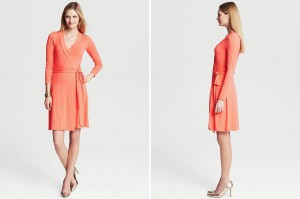In my first post in this series, I discussed the impact that knowing our best colors can have on our lives. When it comes to what is more important, color or lines, it is a bit of a chicken-or-egg question, and many feel that color is more significant. Perhaps because I’m a person for whom wearing an all-black uniform holds a certain appeal, I find lines a lot more important, personally.
Knowing my lines enables me to look over a bunch of garments and understand immediately which ones will work and which ones will make me look like a lumpy bowl of gravy. I no longer waste time with clothes that I know won’t flatter me, and I don’t have to feel bad about myself when I look in the mirror. I no longer wear things that fight against my body lines.
One of the major frustrations with being a type like Flamboyant Gamine is that things that are generally regarded as “universally flattering” for women everywhere don’t work all that well on a Flamboyant Gamine. Jerset wrap dresses are my sworn enemies.

(Source)
What I love about yin/yang systems is that they are all about stopping fighting with yourself. Systems that are strictly body-type based tend to focus on making you what you are not. If you’re short, you should look taller. If you’re curvy, you should look less so. Supposedly, with the “right” clothes, you will arrive at some kind of “medium.” Medium height, some curves but not too much, everything in proportion…
And yin/yang systems say it’s okay to not be a classic. I’m shortish and bluntly angular, rather than curvy, and there’s nothing wrong with that. There’s no point in wishing I had smooth curves that would look great in said wrap dresses. I can wear my short and sculpted dresses instead–which I like better anyway!
Knowing our lines improves our lives in two ways. First, it obviously saves us time because something like 90% of what is in any given store is going to be eliminated immediately, and we will only consider what we know actually works for our bodies. Second, it helps us to embrace our natural beauty rather than wasting time trying to become what we are not.
————————————————————————————————–
Know your type in several systems but having trouble putting it all together? My workbook can help.
Jewel
November 23, 2015 at 4:09 pmI’ve always been a bit confused about the meaning of “lines” in personal style. Here’s what confuses me:
Does it refer the the lines of the person’s body, or the lines of the clothes, or both?
Does it mean whether you look better in curved lines vs. straight lines?
Does it refer to shopping decisions about lines like “straight leg jeans vs. boot cut”?
Does it cover the dilemma of tailored vs. fluid fits?
Thanks in advance for helping me clarify this. I often see style posts discussing how helpful it is to know one’s lines – and I come away from those posts wishing I knew what they mean by that, so I could know my lines too.
stylesyntax
November 23, 2015 at 5:40 pmAll of the above! For instance, I have a broadly angular, choppy/segmented, small body. Fluid fits with a long line would make sense on me at all. So the lines of your body influence which clothing lines look good on you. I sum up how I see everything working together here: http://stylesyntax.com/blog/2015/04/03/type-essence-and-style/
When I say “lines,” I basically mean Kibbe type, since that’s the system I personally refer to most. But there are other systems out there as well.
Jewel
November 26, 2015 at 4:36 amThanks, that was very helpful. Lots of food for thought!
Liz
November 25, 2015 at 12:18 amA book I really found helpful in understanding body lines is “Always in style with color me beautiful”, by Doris Pooser. It talks about color and body line. It covers a spectrum from sharp straight to curved lines, with soft straight lines in between. It gives lots of examples. I think there are several editions but I liked the first one, published I think in 1985, the best. I dont know if its still in print but I got mine through the library. In general I found the drawings helpful, except that the hips are shown getting wider the more curved a persons lines are, which is not necessarily the case.